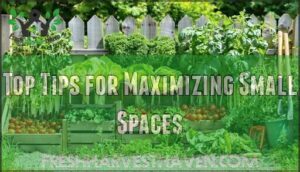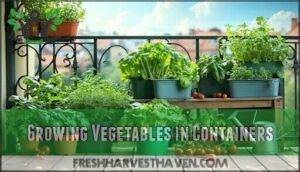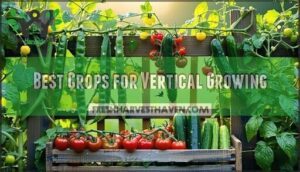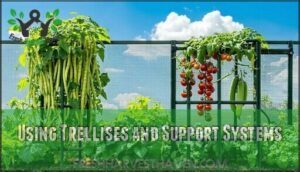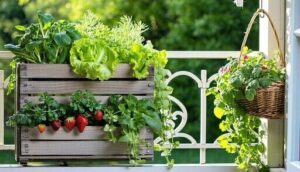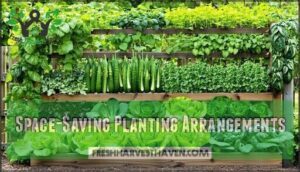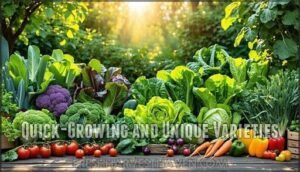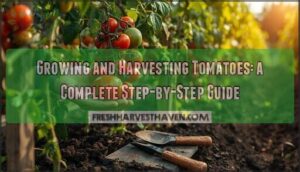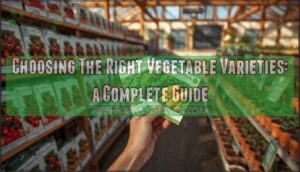This site is supported by our readers. We may earn a commission, at no cost to you, if you purchase through links.
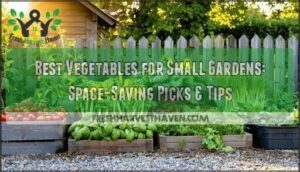
Dwarf tomatoes pump out pounds of fruit from a single pot, bush beans keep producing until frost, and leafy greens pack more nutrition per square inch than almost anything else you can grow. The secret isn’t more space—it’s smarter selection and a few strategic growing tricks that turn limitations into advantages.
Table Of Contents
- Key Takeaways
- Best Vegetables for Small Gardens
- Top Tips for Maximizing Small Spaces
- Growing Vegetables in Containers
- Vertical Gardening Techniques
- Quick-Growing and Unique Varieties
- Frequently Asked Questions (FAQs)
- What vegetables can you grow in a small vegetable garden?
- What are small vegetable garden ideas?
- How to grow vegetables in small spaces?
- What vegetables can be grown vertically?
- What vegetables can you grow in your home?
- Should you include a vegetable garden in your small garden ideas?
- What vegetables for a small garden?
- What is the best size vegetable garden for a beginner?
- What vegetables can grow in 4 inches of soil?
- How to maximize a small vegetable garden?
- Conclusion
Key Takeaways
- Compact vegetable varieties like dwarf tomatoes, bush beans, and leafy greens can deliver surprisingly large harvests in small plots or containers.
- Vertical gardening and smart container choices—like stackable planters or trellises—let you grow more food by going up, not out.
- Succession planting and pairing crops cleverly (companion planting) keep beds productive, extend your harvest, and help fight pests naturally.
- The right soil mixes, regular watering, and space-saving growing tricks are key to keeping small gardens healthy and high-yielding.
Best Vegetables for Small Gardens
You don’t need a sprawling backyard to grow your own food. The right vegetables thrive in tight quarters, producing generous harvests from containers, raised beds, or small plots.
Here’s what actually works when space is scarce.
Compact Tomato Varieties
You’ve got dozens of compact tomato varieties to choose from, ranging from 30 cm micro types like ‘Tiny Tim’ to 120 cm dwarfs like ‘Aftershock.’ Cherry tomatoes such as Sungold and Patio Baby thrive in 5-gallon containers, while BushSteak Tomato and Sweetheart of the Patio Tomato deliver full-sized fruit on space-saving plants.
Disease resistance is built into many compact varieties, making dwarf tomato care straightforward. Thanks to tomato breeding projects, you’ll find options in every color and size for small space gardening.
For successful cultivation, understanding dwarf tomato characteristics is essential.
Dwarf and Miniature Peppers
Dwarf and miniature peppers like Lunchbox Red and Sweet Golden Baby Belle Peppers excel in container gardening, producing 5 to 10 peppers per plant in spaces as tight as 3 gallons. These compact pepper varieties reach just 24–36 inches tall, perfect for small space gardening.
Dwarf breeding has unlocked disease resistance alongside space optimization—varieties like Pompeii yield over 250 g per plant while packing 270% daily vitamin C. That’s serious pepper nutrition in a pint-sized package, ready for miniature harvest in 75–90 days.
Many gardeners also benefit from disease resistant varieties that improve overall crop health.
Small-Space Cucumbers
Bush cucumber varieties like Spacemaster and Bush Champion transform small space gardening. Spacemaster produces 7–8-inch cucumbers on compact 24–36-inch vines—perfect for container vegetable gardening or vertical gardening techniques using simple tomato cages. You’ll harvest up to 60 fruits per Bush Champion plant in just 55 days.
- Space saving: Bush types cut growing area by 65% compared to sprawling vining varieties
- Disease resistance: Spacemaster 80 resists powdery mildew, scab, and mosaic virus—55% fewer infections than standard cucumbers
- Compact growth: Most stay under 18 inches tall, thriving in 12-inch pots with yields matching ground plots at 16 pounds per square meter
Productive Leafy Greens
Leafy greens pack more nutrition per square inch than almost any crop you can grow, and they’ll keep producing for months if you harvest them right. Tom Thumb lettuce matures in 20 days, while kale and chard tolerate both shade and container life beautifully. Cut outer leaves first—your plants regrow for continuous salad greens all season.
| Leafy Green Varieties | Days to Harvest | Container Depth |
|---|---|---|
| Tom Thumb Lettuce | 20 days | 6 inches |
| Kale | 55–75 days | 8 inches |
| Spinach | 30–45 days | 6 inches |
These greens nutrition powerhouses thrive in partial shade—perfect when sun-hungry crops claim your best spots.
Root Vegetables for Containers
Carrots and radishes might seem like backyard garden staples, but they adapt to container life with surprising grace—as long as you give their roots room to stretch. Danvers carrots and Nantes carrots thrive in 12-inch-deep pots with loose, well-draining soil, while small radishes mature in just three weeks in 6-inch containers.
Beets, onion pots, and even potato bins work beautifully when you match container depth to root structure—your small space gardening just got a whole lot sweeter.
High-Yield Beans and Legumes
Pole beans and bush beans deliver more food per square inch than almost any other crop you can squeeze into tight quarters—and they’ll keep producing until frost if you keep picking. Pole beans like Scarlet Runner and Blue Coco climb 6-foot trellises (hello, vertical space!), while bush beans like Helda Romano produce their entire harvest at once—perfect for canning sessions.
Here’s what makes legumes your small garden’s best friend:
- Bean varieties adapt to any container 8+ inches deep
- Legume nutrition fixes nitrogen, feeding your soil while you harvest
- High yield tips: pick every 2-3 days to trigger continuous production
- Bush bean care requires zero staking or fussing
- Pole bean support transforms fence lines into productive zones
Tom Thumb Dwarf Peas even thrive in hanging baskets.
Top Tips for Maximizing Small Spaces
Growing more food in less space isn’t about luck—it’s about strategy. You need varieties bred for productivity, planting schedules that squeeze extra harvests from every square foot, and smart combinations that make plants work together instead of competing.
Here’s how to turn your compact garden into a high-output growing zone.
Choosing High-Yield Varieties
When you’re working with limited space, picking high-yield crops and compact varieties is like choosing the right tools for a tight job—it makes all the difference. Cherry tomatoes rate 9/10 in efficiency, delivering over 13 pounds per plant, while bush beans and leaf lettuce score nearly 7/10.
These productive vegetable varieties also bring disease resistance and adapt well to crop rotation. Smart seed selection means maximizing vegetable yield without sacrificing flavor or forcing you into constant replanting.
Focus on space-saving gardening techniques that let compact vegetables work harder for you.
Succession Planting and Season Extension
Staggered plantings every 2-3 weeks turn succession planning into your secret weapon for maximizing vegetable yield. You’ll harvest fresh greens for months instead of one giant batch.
Cold frames and row covers provide frost protection, extending the growing season by 8-10 weeks for spinach and lettuce.
When you combine succession planting with season extension tools, you can increase your harvest by 30-50%—and keep your picking schedule flexible all year long.
Companion Planting for Productivity
Pairing crops strategically unlocks compound benefits you won’t get growing plants solo. Companion planting boosts vegetable yield by 32% on average while improving pest control and soil enrichment naturally.
Try basil with tomatoes or beans climbing corn stalks—these partnerships increase crop diversity in tight quarters. You’ll see yield optimization through better pollination, fewer pests, and richer soil without adding chemicals or extra square footage.
Managing Sunlight and Shade
Your sunlight map changes hour by hour, and reading it right means the difference between bumper crops and bitter disappointments.
- Full sun zones (6 hours): tomatoes, peppers, cucumbers
- Part shade (3-6 hours): leafy greens with shade tolerance
- Reflected light from walls: doubles container gardening potential
- Garden orientation: south-facing maximizes sun exposure for vertical gardening
Growing Vegetables in Containers
Container gardening gives you total control over your growing conditions—you’re not stuck with whatever soil nature dealt you.
The right setup means healthier plants, easier maintenance, and harvests that’ll make your neighbors jealous.
Let’s break down what you need to get it right.
Selecting The Right Containers
Before you drop a single seed, the container itself deserves serious attention—your choice dictates root health, water retention, and ultimately, harvest success. Container gardening methods range from budget-friendly 5-gallon buckets (perfect for deep-rooted tomatoes) to sleek window boxes for shallow lettuce and herbs.
Space efficiency improves with stackable planters or rail-mounted boxes. Growing vegetables in containers demands drainage systems with holes at the base—waterlogged roots spell disaster. Match planter depth to your crop’s needs, and you’ll discover small space gardening tips that transform even the tightest balcony into a productive container garden.
| Container Type | Best For |
|---|---|
| 5-Gallon Buckets | Tomatoes, peppers, deep roots |
| Window Boxes | Lettuce, herbs, shallow crops |
| Raised Beds | Mixed plantings, drainage control |
| Stock Tanks | Large-scale container gardening |
| Stackable Planters | Vertical space efficiency |
Best Soil Mixes for Pots
Soil quality is crucial for container crops—no amount of sun or water can compensate for a mix that compacts, drains poorly, or lacks nutrients. To ensure your plants thrive, build your own potting soil recipes or select commercial blends rich in organic matter. This will help maintain soil moisture and proper drainage.
Essential components for your small garden mix:
- Peat moss or coco coir – retains moisture without waterlogging roots
- Perlite or vermiculite – ensures container drainage and oxygen flow
- Compost blends – delivers organic fertilizers and balances soil pH management
- Aged bark – prevents compaction in vegetable gardening containers
- Worm castings – slow-release nutrients for season-long feeding
Your container garden will flourish when the mix remains loose, drains quickly, and provides consistent nourishment.
Watering and Fertilizing Container Crops
Container plants can’t stretch their roots to chase moisture or nutrients, so you’ll need to step in with regular watering and feeding to keep them productive. Check soil moisture daily by inserting your finger two inches deep—water when it feels dry, not on a rigid schedule. Apply diluted organic fertilizers every two weeks, or mix slow-release organic amendments into your potting mix at planting.
Your watering schedules should flex with the weather—hot days demand more, cloudy stretches less. Nutrient cycling in containers happens fast, so consistent feeding keeps your harvest coming strong.
| Task | Frequency | Method |
|---|---|---|
| Check soil moisture | Daily | Finger test (2" deep) |
| Water container plants | As needed | Deep soak until drainage |
| Feed with fertilizers | Every 2 weeks | Diluted liquid solution |
Supporting Climbing and Vining Plants
Climbing plants like pole beans and vining squash can triple your harvest without claiming extra ground—but only if you give them sturdy scaffolding to climb. Install a garden trellis or arbor before planting, then train vines upward as they grow—pole beans and Spacemaster cucumber naturally grip holders, while squash needs gentle weaving through the structure.
Vertical vegetables maximize space dramatically, turning a gardening board or wire cage into a productive wall of food.
Vertical Gardening Techniques
When you’re working with limited square footage, the smartest move is to grow up instead of out. Vertical gardening lets you stack your crops and squeeze serious production from even the smallest spaces.
Here’s how to make the most of every inch without turning your garden into a tangled mess.
Best Crops for Vertical Growing
If you’re looking to squeeze the most food from the least footprint, vertical growing is your secret weapon—and some crops practically beg to climb. Pole beans race up vertical space without complaint, while Spacemaster cucumber vines weave through trellis systems like they were born for wall gardens.
Cherry tomatoes thrive when trained upward, turning any fence into a productive powerhouse. These climbing vines don’t just save ground real estate—they make harvesting easier and keep your vertical vegetables healthier.
Using Trellises and Support Systems
A sturdy trellis transforms sprawling vines into space-saving vertical gardens—but choosing the right support system means matching structure to crop weight and growth habit. Here’s what works:
- A-frame trellises – Perfect for balcony gardening with beans and peas
- Cattle panel arbors – Heavy-duty vertical supports for indeterminate tomatoes
- Wire mesh frames – Ideal climbing aids for cucumbers in tight spots
- Bamboo teepees – Budget-friendly trellis designs that optimize vertical space
- String trellis systems – Lightweight spacesaving gardening techniques for leafy climbers
Match your trellis frame to your crop’s vigor—flimsy supports won’t cut it when garden arbors need to manage 20 pounds of ripening squash.
Stackable and Hanging Planters
Stackable planters and hanging baskets let you squeeze herbs, greens, and trailing crops into corners that would otherwise sit empty—think of them as vertical real estate you didn’t know you owned.
Hanging baskets work beautifully for shallow-rooted crops like lettuce and strawberries, while stackable planter boxes with built-in drainage optimize vertical space on balconies.
You’re basically building garden shelves that produce food instead of collecting dust—perfect for container vegetable gardening when your small garden spaces need every square inch to earn its keep.
Space-Saving Planting Arrangements
Instead of planting in rigid rows like your grandparents did, interplant fast growers with slow sprawlers so nothing sits idle while neighboring crops fill out—you’re orchestrating a tight rotation where lettuce matures and clears out just as your tomatoes need the elbow room.
Intercropping methods pair shallow-rooted herbs with dwarf vegetables in raised beds, creating layered planting that maximizes photosynthesis across multiple heights—basically, you’re building a microclimate where compact designs and vertical gardening turn container vegetable gardening into a high-output system.
Here’s how to pack more into small garden spaces:
- Plant lettuce beneath pole beans so greens harvest before beans shade them completely.
- Tuck basil around tomato stems to repel pests and fill gaps in hanging baskets.
- Stagger carrot rows with quick radishes that mark germination lines and harvest first.
- Edge beds with compact herbs like thyme to define borders while producing harvestable crops.
- Layer spinach under trellised cucumbers for a two-story productive footprint.
Quick-Growing and Unique Varieties
When you’re working with limited space, speed matters—and so does personality. Some vegetables race from seed to harvest in under a month, while others pack quirky shapes and colors into compact packages.
Here’s what you need to know about quick-growing crops and unique varieties that’ll make your small garden both productive and interesting.
Fast-Maturing Lettuce and Greens
You’ll get your fastest returns with arugula and loose-leaf lettuce varieties—arugula’s ready in just 30 to 40 days, while leafy types like Black-Seeded Simpson and Red Sails hit harvest size in 45 to 50 days.
Tom Thumb Lettuce and Little Gem lettuce shine in tight quarters, and you can harvest outer leaves repeatedly using the cut-and-come-again method.
Look for bolt-resistant picks like Butterhead or Salad Bowl to keep your salad greens producing through summer heat.
Unusual Dwarf and Miniature Vegetables
Beyond the usual suspects, you’ll find dwarf vegetables that pack full flavor into pint-sized packages.
‘Fairy Tale’ eggplants produce 4-6 inch fruit in just 63 days on compact 18-inch plants, while ‘Thumbelina’ carrots form perfectly round 1-2 inch roots in 65-70 days—ideal for shallow containers.
Try ‘cucamelons’ (Mexican Sour Gherkins) for a grape-sized novelty that climbs trellises and yields 200-300 tiny fruits per plant, or experiment with ‘Kalettes’—a kale-Brussels sprout hybrid forming miniature leafy heads after 120 days.
Compact Herbs for Small Gardens
Herbs deliver maximum flavor per square inch, making them the premier small-space bargain crop. Basil and parsley thrive in 6-inch pots on sunny windowsills, while mint spreads aggressively—contain it or watch it take over. Thyme cascades beautifully from hanging planters, and compact herb varieties like ‘Spicy Globe’ basil stay under 12 inches tall, perfect for tight herb garden designs.
Eye-Catching and Decorative Edibles
Your small garden doesn’t have to choose between beautiful and productive—compact edibles can play both roles at once. Ornamental peppers bring fiery color to containers, while colorful carrots like Thumbelina and varieties in purple or gold double as garden art.
Cherry tomatoes such as Sweetheart of the Patio Tomato shine in hanging baskets, and edible flowers like lettuce blooms and aesthetic herbs transform your space into an edible landscape that feeds both eyes and appetite.
Frequently Asked Questions (FAQs)
What vegetables can you grow in a small vegetable garden?
You don’t need acres to grow food—you need the right vegetables. Tomatoes thrive in containers, and leafy greens mature fast. Vertical gardening turns walls into productive plots.
Compact peppers, small space carrots, micro greens, and pole beans deliver serious yields without sprawling beds.
What are small vegetable garden ideas?
Optimize your small garden with vertical gardening techniques—trellises let vining crops like cucumbers climb upward.
Try container planting on patios or balconies, succession planting for continuous harvests, and choosing compact, high-yield vegetable selections that thrive in tight spaces.
How to grow vegetables in small spaces?
Consider adding trellises or other vertical supports, and opt for high-yield varieties that thrive in container gardens.
Choose containers that suit your crops’ root depth, and fine-tune your soil preparation to match what each plant needs.
Plan your harvests so you can keep enjoying fresh produce all season long.
What vegetables can be grown vertically?
Tomatoes sprawl while beans climb—that’s the difference vertical gardening makes. Pole beans, cherry tomatoes, cucumbers, and even leafy greens thrive on trellis systems and wall gardens.
Climbing vines transform unused vertical space into productive real estate, making small-space gardening smarter and more efficient.
What vegetables can you grow in your home?
Leafy greens, cherry tomatoes, peppers, and compact cucumbers thrive indoors with proper light.
Home gardening lets you harvest fresh vegetables year-round—urban harvest made easy with small space solutions and smart vegetable selection for your indoor farming setup.
Should you include a vegetable garden in your small garden ideas?
Absolutely. Even pocket-sized plots can feed you fresh produce year-round with the right vegetable selection for small gardens.
Urban farming isn’t just practical—it’s your ticket to food independence and garden maintenance that actually fits your life.
What vegetables for a small garden?
Ironically, thinking smaller often yields bigger harvests. Focus on compact vegetable varieties like cherry tomatoes, dwarf peppers, bush cucumbers, leafy greens, and container-friendly carrots—crops bred specifically for thriving in small spaces while delivering impressive production.
Small gardens yield their greatest harvests when you choose compact vegetables built for abundant production in limited space
What is the best size vegetable garden for a beginner?
Start with a 4×8-foot raised bed or four to six containers—enough to learn without getting overwhelmed.
This starter garden lets you test a few crops like tomatoes, lettuce, and peppers while figuring out sunlight, watering, and vegetable selection for small gardens.
What vegetables can grow in 4 inches of soil?
Think of shallow containers like stepping stones—you can cross the garden without sinking deep.
Lettuce, radishes, and herbs thrive in just 4 inches of soil, making them perfect for Container Vegetable Gardening and SmallSpace Gardening setups.
How to maximize a small vegetable garden?
Squeeze every inch from your patch by weaving in vertical planting, tight garden layout, and quick crop rotation.
Use clever soil conservation and SmallSpace Gardening tricks, then focus on productive vegetable selection and varieties suited for small spaces.
Conclusion
A sprawling field isn’t required; ingenuity cultivates abundance where square footage can’t. Tiny plots, bursting with flavor, remind us that the best vegetables for small gardens aren’t just space-savers—they’re powerhouses, fueled by careful choice and clever technique.
Between sunlit windowsills and patio corners, every inch holds the potential for harvest. Let limits inspire, not confine. You have everything you need—just soil, seeds, a little guidance, and the resolve to make your small garden thrive.
- https://harvesttotable.com/vegetable_crop_yields_plants_p/
- https://www.creativevegetablegardener.com/how-long-do-vegetables-take-to-grow/
- https://saltinmycoffee.com/fast-growing-vegetables/
- https://www.foodgardenlife.com/learn/best-vegetables-pots
- https://www.fda.gov/food/nutrition-food-labeling-and-critical-foods/nutrition-information-raw-vegetables

